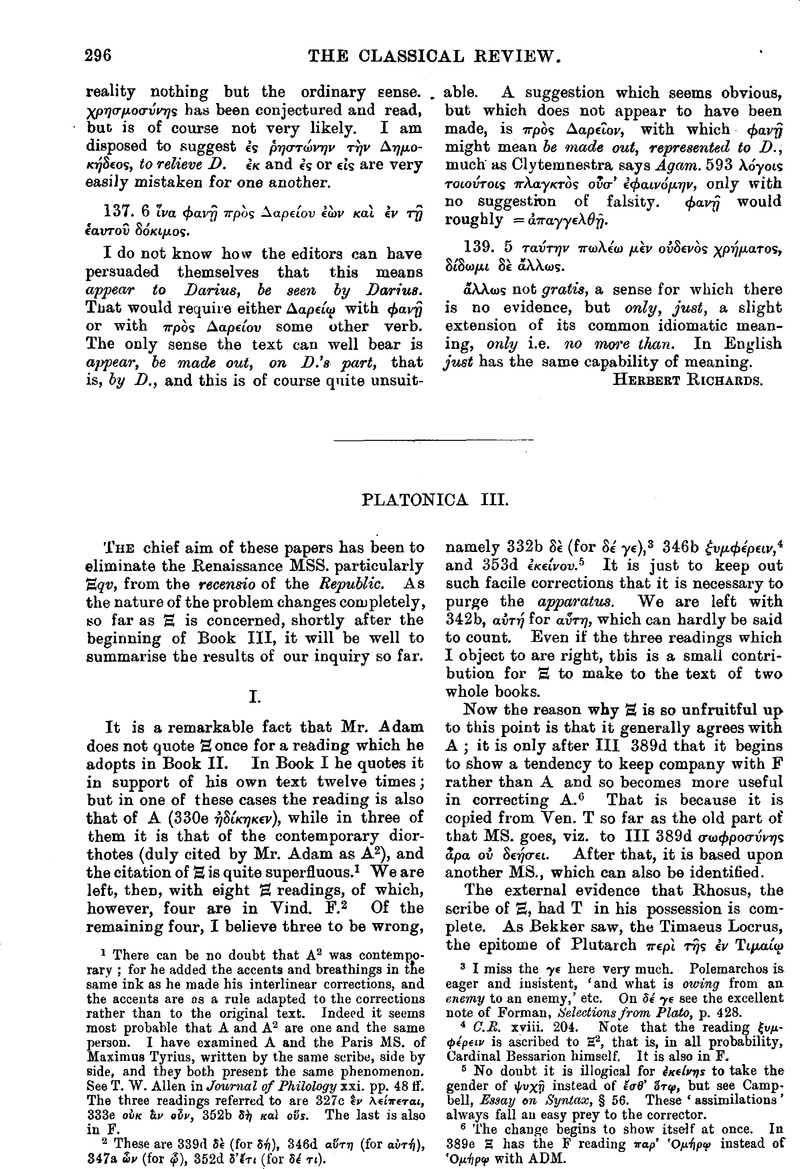No CrossRef data available.

page 296 note 1 There can be no doubt that A2 was contemporary; for he added the accents and breathings in me same ink as he made his interlinear corrections, and the accents are os a rule adapted to the corrections rather than to the original text. Indeed it seems most probable that A and A2 are one and the same person. I have examined A and the Paris MS. of Maximus Tyrius, written by the same scribe, side by side, and they both present the same phenomenon. See Allen, T. W. in Journal of Philology xxi. pp. 48 ffGoogle Scholar. The three readings referred to are 327c ἓν λε⋯πεται, 333e οὐκ ἂν οὖν, 352b δ⋯ κα⋯ οὕς. The last is also in F.
page 296 note 2 These are 339d δέ (for δή), 346d αὒτη (for αὺτή), 347a ὧν (for ᾧ), 352d δ'ἒτι (for δ⋯τι).
page 296 note 3 I miss the γε here very much. Polemarchos is eager and insistent, ‘and what is owing from an enemy to an enemy,’ etc. On δ⋯ γε ye see the excellent note of Forman, , Selections from Plato, p. 428Google Scholar.
page 296 note 4 C.R. xviii. 204. Note that the reading ξυμ-φ⋯ρειν is ascribed to Ξ2, that is, in all probability, Cardinal Bessarion himself. It is also in F.
page 296 note 5 No doubt it is illogical for ⋯κεινησ to take the gender of ψυχῇ instead of ἔσθ' ὅτῳ, but see Campbell, Essay on Syntax, § 56. These ‘assimilations’ always fall au easy prey to the corrector.
page 296 note 6 The change begins to show itself at once. In 389e Ξ has the F reading παρ' Ὁμ⋯ρῳ instead of Ὁμ⋯ρῳ with ADM.
page 297 note 1 Schanz, , Rhein. Mus. xxxiii. 305Google Scholar.
page 297 note 2 Cf. Platocodex, p. 78, n. 1 and Rhein. Mus. xxxiii. 305.
page 297 note 3 These are 333d δ⋯η, 351a ὥ (‘ et fortasse A′’), 363d ⋯ποτ⋯νουσι (C.R. xix. 100), and 375b ⋯λλοισ. (Vind. E is apparently a misprint for Vind. F in Schneider here.)
page 297 note 4 These are 364c βλ⋯ψειν (C.R. xix. 100), and 376a οὐδ⋯ν δ⋯.
page 297 note 5 See Schanz, , Platocodex, pp. 81, 94, 97 ffGoogle Scholar. of course we must remember that Ξ is no mere transcript (see Immisch, O., Philol. Studien ii. p. 14)Google Scholar; but at the same time there can be no doubt that some one MS. regularly formed its ground-text. This comes ont particularly well in the Critias where Ξ is really a transcript of c. Bessarion does not appear to have worked over it.
page 297 note 6 See Schanz, , Hermes x. 173 ff.Google Scholar, Hiller, , Hermes x. 325 sqqGoogle Scholar. (the derivation of c from a holds for Theon of Smyrna and Albinus contained in both), Schanz, , Platocodex, p. 60Google Scholar.
page 297 note 7 I am surprised, however, that Immisch thinks the confusion of ⋯ν ᾗ and ⋯φἰ, to which I called attention in C.R. xvi.' 99, unconvincing. Surely it is only in uncials that ጥΠΙ and ጥΗΙ are likely tobe taken for each other.
page 298 note 1 Platocodex, p. 90.
page 298 note 2 Schanz had seen (Platonis opera IX. p. x) that FS were derived from a common archetype in the Hippias Minor, Io, and Menezemis, and I pointed, out (Platonis opera III praef.) that in S the Homeric citations had been adapted to the ordinary text of Homer, a sure sign of editing. In the Timaeus, S represents an entirely different tradition, but o continues to go very closely with F. It is not, however, derived from it, as Schanz supposed (Platocodex, p. 105), but from a corrected copy of the same archetype. We have, in fact, two traditions of this archetype, but only that represented by F is free from corrections taken from other families of MSS.
page 298 note 3 In this case A is wrong and F very nearly right. The true reading, μεμιμ⋯σθαι, is found in Σ0, the misspelling in F represents an earlier stage of the corruption in a.
page 298 note 4 This is specially instructive; for Cobet (Mnem. 1875, p. 196) cites the preservation of σ⋯σωται as proof of the unique excellence of Par. A. ‘Quis codex, omnium quos habemus,’ he says, ‘tarn bonus testis est ut servet σ⋯σωΤαι et διασ⋯σωΤαι? Nullum umquam vidi.’ The scribe of A was evidently struck by the form; for he repeats it in the margin. The Metropolitan Constantino has of course ‘corrected’ it to σ⋯σωται in his ugly hand.. Just below in 110a διασ⋯σωται appears in F as δισ⋯σωσται, which shows that we have to do with tradition and not grammatical theory in the first passage.
page 298 note 5 This is an instructive example in another way. In F the second hand (f) has made piav into ρἰων into ρε⋯ων, and in Flor. x we have accordingly Ὀ… ρε⋯ων. Ang. ν. has preferred to write Ὀρ⋯ων. The ῥ⋯ων of ‘corr. Σ,’ which also occurs in acΞ looks like an attempt to Atticise ῥεἰων!
page 299 note 1 It is true they occur in one MS. (i); but, according to Schanz, that is copied from the Aldine. I suggest as a question for further inquiry whether it may not be the press copy from which the Alditie was printed.